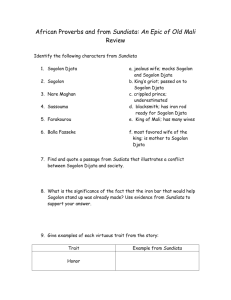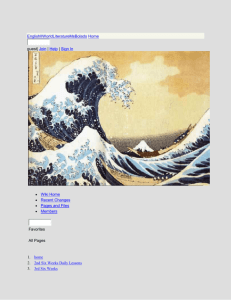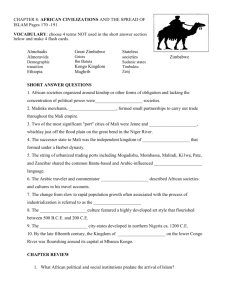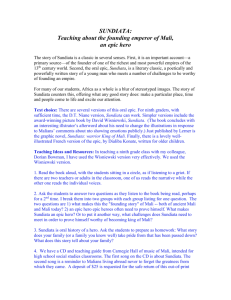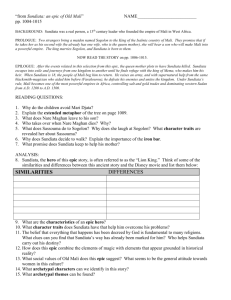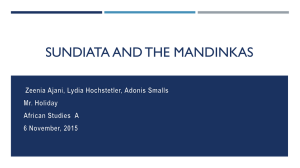ERIC article - Sundiata analysis
advertisement
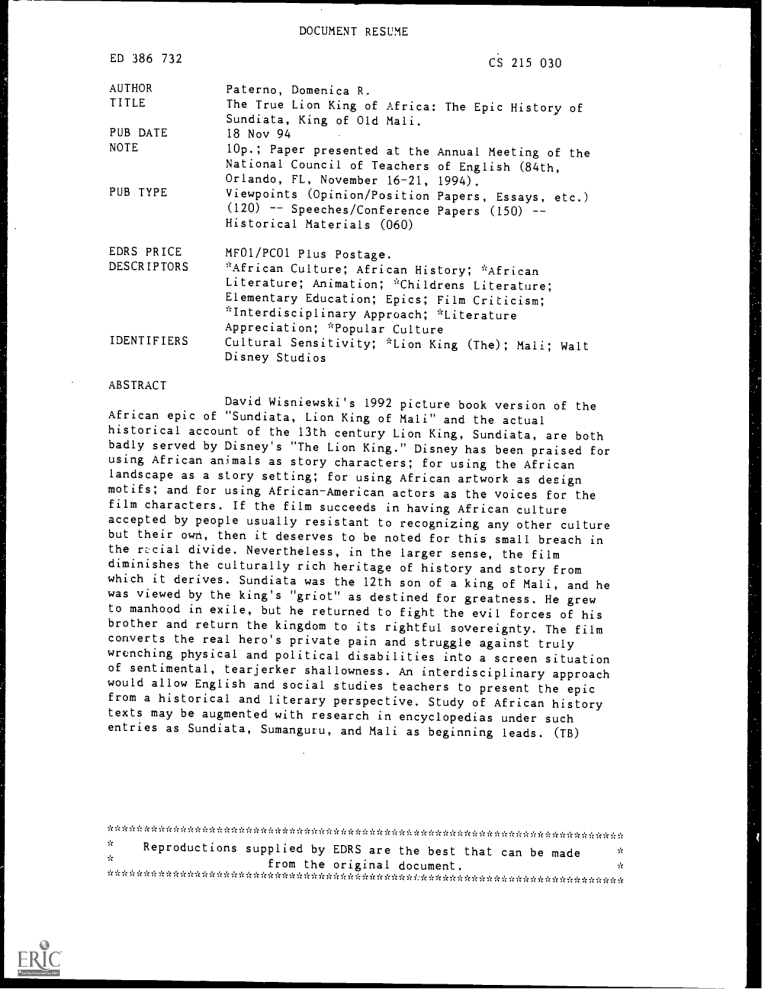
DOCUMENT RESUME ED 386 732 AUTHOR TITLE PUB DATE NOTE PUB TYPE EDRS PRICE DESCRIPTORS IDENTIFIERS CS 215 030 Paterno, Domenica R. The True Lion King of Africa; The Epic History of Sundiata, King of Old Mali. 18 Nov 94 10p.; Paper presented at the Annual Meeting of the National Council of Teachers of English (84th, Orlando, FL, November 16-21, 1994). Viewpoints (Opinion/Position Papers, Essays, etc.) (120) Speeches/Conference Papers (150) Historical Materials (060) MF01/PC01 Plus Postage. *African Culture; African History; *African Literature; Animation; *Childrens Literature; Elementary Education; Epics; Film Criticism; *Interdisciplinary Approach; *Literature Appreciation; *Popular Culture Cultural Sensitivity; *Lion King (The); Mali; Walt Disney Studios ABSTRACT David Wisniewski's 1992 picture book version of the African epic of "Sundiata, Lion King of Mali" and the actual historical account of the 13th century Lion King, Sundiata, are both badly served by Disney's "The Lion King." Disney has been praised for using African animals as story characters; for using the African landscape as a story setting; for using African artwork as design motifs; and for using African-American actors as the voices for the film characters. If the film succeeds in having African culture accepted by people usually resistant to recognizing any other culture but their own, then it deserves to be noted for this small breach in the rcial divide. Nevertheless, in the larger sense, the film diminishes the culturally rich heritage of history and story from which it derives. Sundiata was the 12th son of a king of Mali, and he was viewed by the king's "griot" as destined for greatness. He grew to manhood in exile, but he returned to fight the evil forces of his brother and return the kingdom to its rightful sovereignty. The film converts the real hero's private pain and struggle against truly wrenching physical and political disabilities into a screen situation of sentimental, tearjerker shallowness. An interdisciplinary approach would allow English and social studies teachers to present the epic from a historical and literary perspective. Study of African history texts may be augmented with research in encyclopedias under such entries as Sundiata, Sumanguru, and Mali as beginning leads. (TB) *********************************************************************** Reproductions supplied by EDRS are the best that can be made * * from the original document. ******************************************)%*.AA*AA.*A,%**;.AA**AAAAA:.A:.AA* The Truc Lion King of Africa: The Epic History of Sundiata, King of Old Mali Presentation National Council of Teachers of English 84th Annual Convention Orlando, Horida 18th November 1994 U.S. DEPARTMENT OF EDUCATION Office ot Eoucabonal RISOarCh IMO 1.12rOnernent -PERMISSION TO REPRODUCE THIS MATERI HAS BEEN GRANTED BY EDUCATIONAL RESOURCES INFORMATION CENTER (ERICI fichiS OOCument his been :ece.vey from the perSO. reproduced as 01\7\AD ortginsting it 0 Mmor changes have Or organuahon reprodochOn cluahty been made to .rnprove Poin t! of voew Or op...originator:I TO THE EDUCATIONAL RESOURCES INFORMATION CENTER IERIC1 5 th.sclocumen! do not r*Cesseray OERI poethon or poky rpresent ofItc.sI Speaker Domenica R. Paterno, Ph.D. Assistant Professor in English Education Lehman College of the City University of New York Department of Secondary Education 250 Bedford Park Boulevard West Bronx, New York 10468 (1) 718 960-7896 Dept. Office: 8171 FAX 7855 . Home 34 Robin Hill Road Scarsdale, New York 10583-2640 (1) 914 472-1508 BEST COPY AVAILABLE Listen to me, children of the Bright Country, and hear the great deeds of ages past. The words I speak are those of my father and his father before him, pure and full of truth. For we are griots. Centuries of law and learning reside within our minds. Thus we serve kings with the wisdom of history, bringing to life the lessons of the past so that the future may flourish. Listen, then, to the story of Sundiata, the Lion King, who overcame all things to waik with greatness. Thus begins David Wisniewski's 1992 version of the African epic of the Sundiata, Lion King of Mali. In that opening we may discern the openings of other epics: Of Gilgainesh: 'The one who saw the abyss I will make the land know; of him who knew all, let me tell the whole story ... [of] the lord of wisdom, he who knew everything, Gilgamesh, who saw things secret, . .. traveled the road exhausted, in pain, and cut his works into a stone tablet." Of The lliad: "Sing, goddess, the anger of Peleus' son Achilleus / and its devastation, which put pains thousandfold upon the Achaians, / hurled in their multitudes to the house of Hades ..." Of The Aeneid: 'This is a tale of arms and of a man. Fated to be an exile, he was the first to sail from the land of Troy and reach Italy, at its Lavinian shore. And of Beowulf: "Hear! We know of the bygone glory of the Danish kings, and the heroic exploits of those princes." But the hero's tale told in the Sundiata, although having elements which are universal to the genre, has roots which are uniquely and exclusively African. The epic is based on the life of a true African king who, in the thirteenth century, forged an empire in West Africa extending from the Atlantic coast eastward into the present-day countries of Gambia, Guinea, Sundiato * raterno * 1 Senegal and Mali. The tale is addressed to the descendants of that ancient country, Mali, by the "griot", the traditional African storytelling sage, the oral historian, the law-keeper, and the memory-keeper of his people. And the listeners are addressed as the "children" of that "Bright Country": as the descendants of a heritage bright with courageous deeds and cultural accomplishments, and rich in the treasures of real gold (from Malinke mines), enlightened leaders and ancient wisdom. The historical facts are these: In the early twelve-hundreds, the subSaharan kingdom of Sosso (Ghana) was ruled by the powerful Sumanguru. In his attempt to conquer the Malinke state of Kangaba, Sumanguru killed eleven princes of the royal Keita family, sparing only the young and sickly son, Sundiata. The boy was thought to be so close to death that he posed no threat to Sumanguru's plans for conquest. Sundiata went into exile. He formed a private army and stayed close to his people. He forged alliances with rulers of other West African states. In 1235 he encountered and defeated Sumanguru at the battle of Kirina. In 1240 he seized the capital of Ghana and destroyed all vestiges of Sumanguru's former power. By acquiring the goldmine fields at Wangara, and by establishing his capital at Niani, a trading crossroads, Sundiata was able to bring peace, sovereignty and prosperity to his West African kingdom of Kangaba. Upon this foundation the empire of Mali flourished for fifteen hundred years, reaching its peak in the fourteenth century when it became the center of learning, law and commerce for the entire West African Sudan. David Wisniewski's picture book version is based upon the oral telling by the Keita clan griot, Marnoudou Kouyate, as written down by Djibril Tansir Niane, and as translated from the original Malinke by G. D. Pickett. In both Sundiata Paterno * 2 his words and pictures Wisniewski follows the original griot oral tradition of telling truth through story: he enfuses historical fact with fictive devices. Thus his vision is at once historically authentic and literarily imagined. Magic and sorcery embellish incidents from the factual record. Characters hold not the complexity and density of historical figures, but the monumental simplicity of story villains and heroes. And the action, plotted more as story than as chronicie account, swiftly moves the hero from private weakness to public power, while providing him with only enough challenge to make the final victory valiantly worthy. The punishment of the evildoer and the defeat of evil, the triumph of the hero and the flourishing of the good those perennial themes of literature-- are here captured by Wisnieswski in a modern version of an historical narrative eight hundred years old. Sundiata, according to the recitation of the Keita griot, was born the twelfth son of Maghan Kon Fatta, king of Mali. His mother, Sogolon, was a maiden "hunchbacked and ill-favored". Yet it was said that she possessed the strong and courageous spirit of the buffalo. On the advice of his griot, King Maghan married Sogolon, hoping to produce a son who combined his spirit of the lion with hers of the buffalo. But the new prince, Sundiata, though blessed by the spirits of buffalo and lion, proved unable to speak or walk.... For seven years Sogolon tried in vain to heal her son with potions and herbs. Sundiata dragged himself through the palace, ignored by some, ridiculed by others. Although his mother was heartbroken and his father despaired, Sundiata was viewed by the king's griot as being destined for greatness. Upon King Maghan's death, his wishes to have Sundiata succeed him were ignored. Maghan's first wife, Sassouma Berete, who hated and feared Sundiata, saw that her own son was installed on the throne. As mother of Sundiata * Paterm, * the ruling king, Sassouma taunted Sogolon about her mute and crippled child: "It would seem that a walking boy is better than a crawling lion." Sundiata could not see his mother thus humiliated. He sent his faithful griot, Balla Fasseke, for an iron rod. Driving the rod into the ground, Sundiata grasped it and painfully raised himself to his knees. Then with another great effort, Sundiata stood upright for the first time in his life. The now bent rod fell away and Sundiata stood freely and strongly on his own feet. Sassouma, fearing Sundiata's growing power, attempted to use witchcraft to destroy him. But Sundiata's goodness defeated the woman's wicked magic. Then Sassouma banished Sundiata's friend and griot, Balla Fasseke, to the court of Sasso, ruled by the evil sorcerer king, Sumanguru. Fearing further harm to her family, Sogolon chose the road of exile for herself and her family. As he grew to manhood in exile, in the kingdoms which took him in, Sundiata was recognized as a courageous warrior and a wise leader. He served the king of Mema so well that Sundiata was made heir to the Mema throne. But Sundiata left Mema when the tyrant Sumanguru invaded his homeland, Mali. The king and his evil mother, Sassouma, had fled; the people were leaderless; and the Malinke seers prophesied that only Sundiata could save his people and return the kingdom to its rightful sovereignty. Sundiata gathered a great army from the kingdoms which had supported him in exile. He encountered Sumanguru's forces on the plain of Kirina. In the midst of the fray, Sundiata is united with his friend and griot, Balla Fasseke. Banished to the Sasso court, the griot had learned Sumanguru's tana, the secret charm which held the power to utterly destroy the tyrant's might. Balla gave Sundiata the tana, a wooden arrow tipped with Sum /iota * Paterno * 4 sorcerer. Sumanguru, pursued by Sundiata and Balla, escaped to the slopes of Mount Koulikoro where he sought safety in a stone cavern, only to become one with the rock of the mountain, never to be seen again. His leaderless army went down in defeat. Sundiata returned in glory to Mali. "Hatred drove me from this land," he said, "because of what I seemed to be: a crawling child, unworthy of respect and unfit to rule. Mali has suffered great hardship as a result." "Now I return as your king. Henceforth, none shall interfere with another's destiny. You, your children, and your children's children shall find their appointed place within this land forever." This came to pass, and Sundiata, the Lion King, ruled the Bright Country for many golden years. I have presented both the historic and the literary versions of this African hero tale because I seek to place the truth of history and epic as necessary context for (if not argument against) the Disney animated film rendition of the Lion King story which now pervades our (popular) culture. My purpose is to restore the authenticity of the true Lion King, as historical personage and as epic hero. The Disney Studio has been praised for using African animals as story characters; for using the African landscape as story setting, and African artwork as design motifs. The film has also been lauded for using AfroAmerican actors as the voices for several film characters. And if the film succeeds, through its highly entertaining mode of presenting these African elements, in having African culture accepted by people usually resistant to recognizing any culture but their own-- then the film deserves to be noted for this small breach in the racial divide. But in the larger sense the film may be said to diminish the culturally rich heritage of history and story from which it derives. The film replaces a cuudiata * ['Memo * genuine African hero with an animated caricature of one. It converts the real hero's private pain and struggle against truly wrenching physical and political disabilities into a screen situation of sentimental, tear-jerker shallowness. History's true account of the devastating battle at Kirina is reduced in its film counterpart to a fast-action, special-effects romp. The acute vision of the griot, who instructs in righteousness as he tells his tale, is replaced in the film by the cute song lyrics advice of a pseudo sage. This preemption of the magnificent original epic, carried down for eight.centuries through the skill and memories of chanting griots should not prevail. An interdisciplinary approach would allow English and social studies teachers to present the epic from an historical and a literary perspective. Study of African history texts may be augmented with research in junior and senior encyclopedias under such entries as: Sundiata, Sumanguru, Mali and Malinke, as beginning leads. Although at present no other junior version of the Sundiata is in print but David Wisniewski's picture book version, nevertheless libraries may have in their collections previously published editions. Wisniewski's text and illustrations may be plumbed by middle and high school students for their rich literary and historical allusions; primary graders will enjoy them for their detailed storytelling qualities. The literary definition of the epic may be applied to the Sundiata, since it deals with a human, not a divine, protagonist, and since it recounts "heroic deeds." It may then be compared with other epics in the canon, from Gilgainesh, to Beowulf. Like Gilgamesh, who loses Enkidu, Sundiata suffers the loss of his friend, Balla. Like Odysseus, he wanders in exile before being able to return to his homeland. Like Beowulf, he slays those evildoers who would bring devastation on his people. Like Aeneas he founds a country. 8 Stindititti * Paterno What is unique to each epic is its cultural context. What is generic to all epics is the story of the rise of humankind, told through the metaphors of battle and journey, from the darkness of ignorance, weakness, enslavement and despair into the brightness of wisdom, strength, liberation and hope. As teachers we can present our students with no greater metaphor than that which appears in the Sundiata: the story of a real man of Africa, born a crippled mute, who conquered his physical disabilities to become a wise warrior, an enlightened sovereign of his people. In this day of drive-by shootings, the (Sundiata) epic teaches that torce should be used only in the service of good. In this day of metal detectcrs in the schools, the (Sundiata) epic teaches that the evildoer will be destroyed by his own weapon of evil. In this day of racial, ethnic and class divisions, the (Sundiata) epic teaches that a man may emerge from the lowliest of circumstances to become a force for unification of all peoples. 'The case for literature,' wrote Denys Thompson, "is that it stands for humanity at a time when the human values are not upheld, as they used to be, by religion and the home, or even by education itself as a whole." Let us as teachers of literature make the case for human values by telling the story of humanity in all its rich diversity. Sunditita * Paterno * 7 REFERENCES , Sundiata: An Epic of Old Mali. Compiled and written by Djibril Tamsir Niane. From the words of Djeli Mamoudou Kouyate, Griot of the Keita Clan. Translated from the original Malinke by G. D. Pickett. London, 1965. Translated from the French by G. D. Pickett. Essex, England: Longmans, 1986. Sundiata: Lion King of Mali. Story and Pictures by David Wisniewski. New York: Clarion Books, 1992. Beowulf. A Prose Translation by David Wright. New York: Penguin Books, 1957. Gilgamesh. Translated by John Gardner and John Maier. New York: Alfred A. Knopf, 1984. The Iliad of Homer. Translated by Richard Lattimore. Chicago: University of Chicago Press, 1951. Virgil: The Aeneid. Translated into Prose by W. F. Jackson Knight. New York: Penguin Books, 1956. Fleming, Margaret, Editor. Teaching the Epic. Urbana, Illinois: National Council of Teachers of English, 1974. Note: Although Fleming does not deal specifically with the Sundiata, her introductory essay and the section on "National Epics" are unsurpassed as preparatory materials for teaching this (or any) epic. Vance, Sidney. "Contending with the Masculinist Traditions: Sundiata's Sogolon and the Wife of Bath." In Global Perspectives on Teaching Literature. Sandra Ward Lott, Maureen S. G. Hawkins, and Norman McMillan, Editors. Urbana, Illinois: National Council of Teachers of English, 1993. PP. 101-108. Vance deals with teaching the original (G. D. l'ickett translation) Sundiata to college students. Her feminist perspective of focusing study on the woman's strengths she discerns in Sundiata's mother, Sc)gcilon, is also a valid approach for secondary students-- when (and if) an appropriate text becomes available. Note: Thompson, Denys. Quoted in, The Uses of English. Herbert J. Muller. New York: Hoit, Rinehart and Winston, Inc., 1967. P. 77. 10 Sundiata * Paterno * 8
